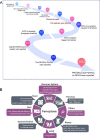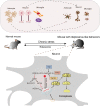Targeting the ferroptosis crosstalk: novel alternative strategies for the treatment of major depressive disorder
- PMID: 37901286
- PMCID: PMC10603325
- DOI: 10.1136/gpsych-2023-101072
Targeting the ferroptosis crosstalk: novel alternative strategies for the treatment of major depressive disorder
Abstract
Depression is a major contributor to poor global health and disability, with a recently increasing incidence. Although drug therapy is commonly used to treat depression, conventional antidepressant drugs have several disadvantages, including slow onset, low response rates and severe adverse effects. Therefore, developing effective therapies for depression remains challenging. Although various aetiological theories of depression exist, the underlying mechanisms of depression are complex, and further research is crucial. Moreover, oxidative stress (OS)-induced lipid peroxidation has been demonstrated to trigger ferroptosis. Both OS and ferroptosis are pivotal mechanisms implicated in the pathogenesis of neurological disorders, and investigation of the mediators involved in these processes has emerged as a prominent and active research direction. One previous study revealed that regulatory proteins involved in ferroptosis are implicated in the pathogenesis of depression, and antidepressant drugs could reverse depressive symptoms by inhibiting ferroptosis in vivo, suggesting an important role of ferroptosis in the pathogenesis of depression. Hence, our current comprehensive review offers an up-to-date perspective on the intricate mechanisms involved, specifically concerning ferroptosis and OS in the context of depression, along with promising prospects for using molecular mediators to target ferroptosis. We delineate the key targets of molecular mediators involved in OS and ferroptosis implicated in depression, most notably reactive oxygen species and iron overload. Considering the pivotal role of OS-induced ferroptosis in the pathogenesis of neurological disorders, delving deeper into the underlying subsequent mechanisms will contribute significantly to the identification of novel therapeutic targets for depression.
Keywords: depression.
© Author(s) (or their employer(s)) 2023. Re-use permitted under CC BY-NC. No commercial re-use. See rights and permissions. Published by BMJ.
Conflict of interest statement
Competing interests: None declared.
Figures





References
-
- Brody DJ, Pratt LA, Hughes JP. Prevalence of depression among adults aged 20 and over: United States, 2013-2016. NCHS Data Brief 2018:1–8. - PubMed
Publication types
LinkOut - more resources
Full Text Sources
